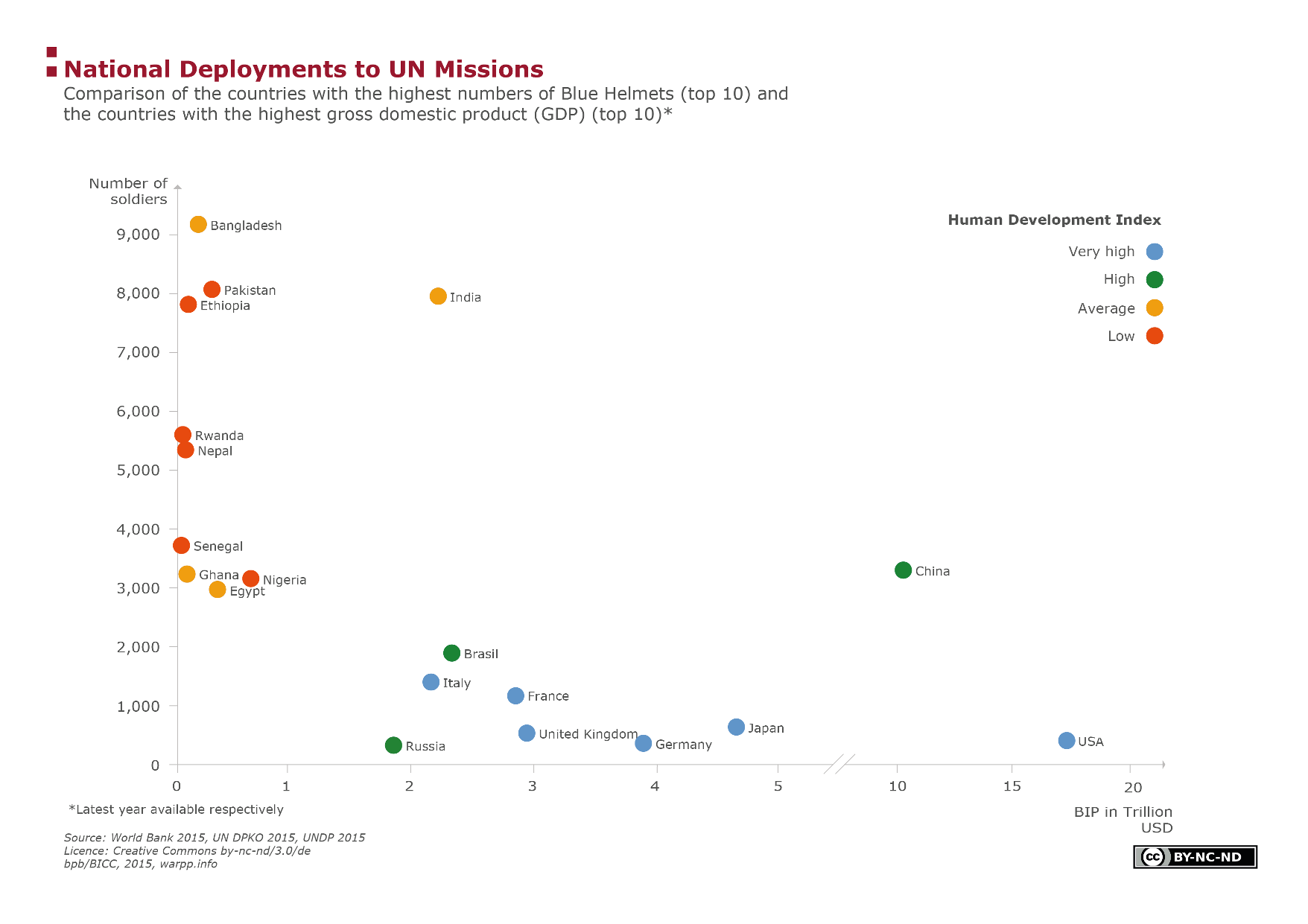National Deployments to UN Missions

The graph shows the size of national troops participating in UN missions (2015). It compares the ten countries that sent the most troops to UN peacekeeping operations (based on data provided for April 2015) to the ten countries with the highest gross domestic product (GDP). The number of soldiers is shown on the vertical axis. The gross domestic product of the countries (in thousands of billions of US dollars) is shown on the horizontal axis. The colours of the dots indicates the countries' levels of development according to the Human Development Index (blue - very high, green - high, orange - medium, red - low).
Facts
The majority of soldiers is sent from countries that have a low GDP and show low to moderate development. While the largest share of more than 9,000 soldiers comes from the developing country of Bangladesh, countries with the highest GDP worldwide and a high to very high level of development tend to send fewer soldiers, on average up to 2,000 per country. In comparison, the richest country, the United States, makes the fewest resources available.
Exceptions of this are only India and China. India is the only country that belongs both to the group of countries with the largest allocation of troops and the groups of countries with the highest GDP. Yet, it is also the only country of the wealthiest top 10 that shows moderate rather than high or very high development. What is noticeable with China is that it has the second-highest GDP in the world (after the United States) with approx. 10,000 billion US dollars and that, at the same time, it is prepared to make its troops available. Of the ten wealthiest countries in the world, it makes the second-most troops available (after India) for UN missions, albeit significantly fewer numbers.
Poorer countries have a higher interest in sending troops to UN peacekeeping operations than richer countries do. One reason for this is the compensation paid by the United Nations to the country for the troops sent. It amounts to US $1,332 for each soldier participating in UN missions. Armies in rich countries, though,are paid more than what the United Nations pay. In poorer countries, vice versa, the compensation paid by the United Nations is higher than the pay of a soldier. Poor countries, therefore, profit financially when they contribute soldiers to UN missions. For rich countries, however, there is no financial incentive to send soldiers to UN peacekeeping operations.
Terms, notes on methodology or reading aids
The Gross domestic product (GDP) is the total value of everything produced by all the people and companies within a country's borders over a year. Part of the GDP is the production of goods and services in a country after having deducted preliminary work (goods and services that were used to manufacture other goods) and imports. The height of the GDP is therefore used as an indicator of country's economic performance.
Due to their characteristic blue helmets, one often refers to those participating in a United Nations peacekeeping operation as Blue Helmets. Peacekeeping operations are led by the Department of Peacekeeping Operations - DPKO. The military, the police and civilian personnel participate in UN missions. Their tasks are to protect civilians, to advance the disarmament and reintegration of ex-combatants, to foster the organization of elections or to advance the protection of human rights.
Data sources
UN DPKO (United Nations Department of Peacekeeping Operations) On behalf of the UN Secretary General, the DPKO leads the peace forces of the Member Countries during monitoring missions and peace operations. Data on past and current peace operations can be found on the websites of UN DPKO. Due to the major fluctuation in numbers of personnel, the United Nations publish updated data on a monthly basis. The data on personnel of the UN DPKO mirror the total number of police and military personnel as well as military experts that are made available by the respective countries for UN missions.
The World Bank The World Bank is located in Washington, DC. It is a vital source of financial and technical assistance to developing countries around the world. Its focus lies in combating poverty in a sustainable manner through further training activities and advisory services. The World Bank has 188 members and is divided into five institutions. It obtains its data indicators on the population from the United Nations. United Nations estimates are based on the latest official census seen as not all countries' governments provide exact figures for each year. It takes into account the birth and death rates as well as international migration.
The World Bank – Data – Indicators – Population
UNDP (United Nations Development Programme) UNDP has published its annual Human Development Index (HDI) since 1990. The Index is used as a prosperity index worldwide and shows differences in development. The Index is a summary measure of average achievement in key dimensions of human development: life expectancy, years of schooling and vocational training, being knowledgeable and gross national income per capita. Countries are grouped according to their HDI value of one of the four categories: very high human development, medium human development and low human development.





